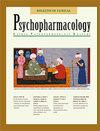Frequency of Synthetic Cannabinoid Use and Its Relationship with Socio-Demographic Characteristics and Treatment Outcomes in Alcohol- and Substance- Dependent Inpatients: A retrospective study
Q Medicine
Klinik Psikofarmakoloji Bulteni-bulletin of Clinical Psychopharmacology
Pub Date : 2015-12-01
DOI:10.5455/BCP.20150207072424
引用次数: 50
Abstract
ABS TRACT: Frequency of synthetic cannabinoid use and its relationship with socio-demographic characteristics and treatment outcomes in alcohol- and substance-dependent inpatients: a retrospective study Objective: The recent emergence of Synthetic Cannabinoids (SCs) has become a serious public health problem. Here we aimed to analyze the frequency of SC use and its relationship with sociodemographic characteristics and treatment outcomes in alcohol- and substance-dependent inpatients retrospectively. Methods: We retrospectively analyzed medical records of 323 inpatients that were treated at the alcohol and substance dependence treatment center between January 2012 and December 2013. The data were extracted from patient records. Results: The mean age of SC users was lower than for patients without a history of SC use. The mean duration of education was shorter for SC users. Age at first drug use of SC users was lower, numbers of hospitalizations were lower and duration of substance use was shorter in SC users compared with the other substance user groups. The rate of legal issues was higher in the SC-use group. The rate of lapse and the rate of dropout was higher in patients with SC use than in other substance users (for all p< 0.05). Age, age at first substance use, duration of use (years) and criminal records were predicted as determining variables for SC use in inpatients. Conclusions: In conclusion, the socio-demographic characteristics can be included as predictive factors for SC use.酒精和物质依赖住院患者合成大麻素使用频率及其与社会人口学特征和治疗结果的关系:一项回顾性研究
摘要:酒精和物质依赖住院患者合成大麻素的使用频率及其与社会人口学特征和治疗结果的关系:一项回顾性研究目的:合成大麻素(SCs)的出现已成为一个严重的公共卫生问题。本研究旨在回顾性分析酒精和物质依赖住院患者使用SC的频率及其与社会人口学特征和治疗结果的关系。方法:回顾性分析2012年1月至2013年12月在酒精和物质依赖治疗中心接受治疗的323例住院患者的病历。数据是从患者记录中提取的。结果:SC使用者的平均年龄低于没有SC使用史的患者。SC使用者的平均教育时间较短。与其他物质使用者组相比,SC使用者首次吸毒的年龄较低,住院次数较低,物质使用持续时间较短。法律问题的发生率在使用sc的组中更高。使用SC的患者的失效率和退出率高于其他物质使用者(均p< 0.05)。年龄、首次使用药物的年龄、使用时间(年)和犯罪记录被预测为住院患者使用SC的决定变量。结论:总之,社会人口学特征可以作为SC使用的预测因素。
本文章由计算机程序翻译,如有差异,请以英文原文为准。
求助全文
约1分钟内获得全文
求助全文
来源期刊
CiteScore
0.34
自引率
0.00%
发文量
0
审稿时长
6-12 weeks

 求助内容:
求助内容: 应助结果提醒方式:
应助结果提醒方式:


